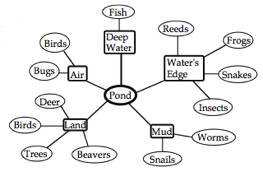
Water Biodiversity and the Food Web
Teacher Guide - Global Lab

|
In this activity, students begin summarizing their work in a qualitative way - they consider which communities in and around their water appear to be most common and what surprises they found in the field. They return to their biodiversity concept maps to make changes and additions resulting from their fieldwork, and build possible food webs for their site. Finally, they are introduced to the abiotic topics that will be the focus of their research during The Water Investigation.
Students' work on their concept maps show that the amount of life at the study site extends far beyond what they commonly notice, or can even observe with the naked eye. The diverse communities interact and support one another. Their success depends not only on the physical and chemical conditions of the water but also on the other communities with which they interact. |
Materials
Communities and Food Webs (background reading)
index cards
string or yarn
tape |
Activity-at-a-Glance
- Students explore the extent of biodiversity at their site and see the diversity of communities that exist in and around their body of water.
- Students are introduced to the research teams in which they will study abiotic factors influencing their body of water.
Students can use yarn or string and tape to link their cards together. If you have a digital camera, you may want to photograph the webs for posting on a class Web site.
Classroom Management and Preparation
The activity begins as a class discussion, but students work in teams to construct the food webs and build their concept maps.
Recommended Student Reading
Communities and Food Webs |
Recommended Steps
1. Discuss with students the results of the field trip.
How biologically diverse is water? Do you think it might be more diverse than your sampling indicates? Why or why not? How might the biodiversity of land relate to the biodiversity of water?
2. Have student teams link their index cards to create a food web for their body of water.
To create the food web, students will have to make reasoned guesses about the interactions among various organisms and communities. Encourage them to try different options and record the rationale behind each. One strategy is to start with the bottom of the food chain and work up. Alternatively, they can begin with large animals at the top of the chain and work down.
It is important for students to understand that different communities interact with one another. Students will need to consider questions such as: What different communities did you observe in the field? Do they interact? How? What are the pros and cons of different species living together? How might these interactions work to strengthen the communities as a whole?
As they are building their food webs, have students add to and revise their concept maps. They should now be able to include organisms such as algae and other plants, bacteria, and microscopic life that may not have been included in the first version.
3. Have student teams present their food webs and concept maps.
Allow students time to review one another's work and compare their findings. They can revise the food webs and concept maps individually as homework, or build a class web and map to post on the class Web page.
4. Discuss with students other factors affecting the quality of the water at the study site.
What factors are not yet included in students' concept maps? What effect might these factors have on the life in the water and its diversity? Are they the same factors that are at work on land? How might they be different?
As a lead-in to the abiotic factors that are the focus of the third investigation, you may want to introduce the factors of light, temperature and energy, surface tension, salinity, and evaporation.
|
Extensions
Have the students investigate the differences between aquatic food webs and those found on land. |
Assessment
Maps that result from this activity should show a depth of understanding about biodiversity and communities. Students should be able to better identify factors at work on the study site, the direction of their influence, and the organisms and communities they influence. The research students do in The Water Investigation contribute to a more complete portrait of life in and around your body of water.
|
Back to Global Lab Water Life Index
Back to Global Lab Water Index |

